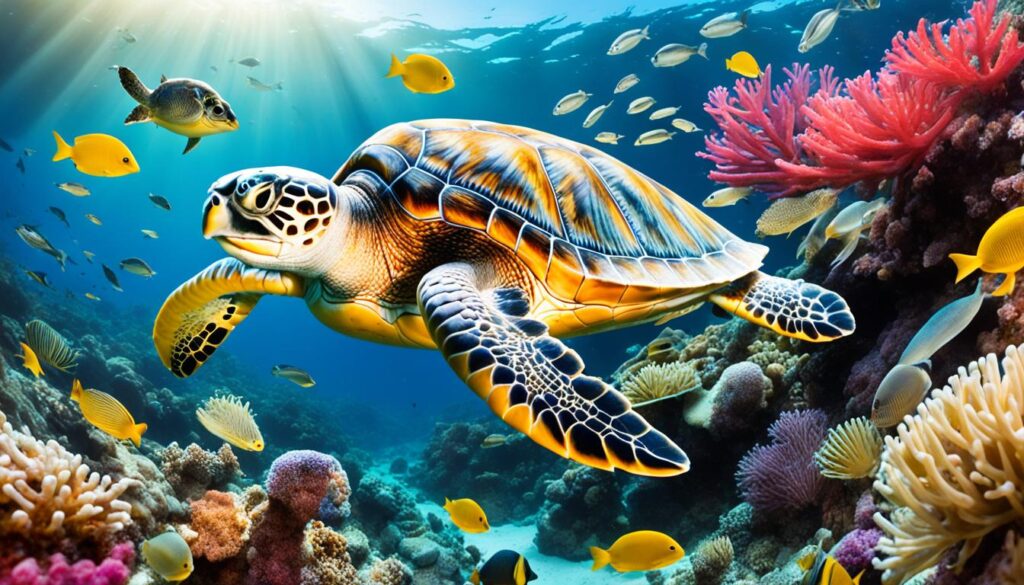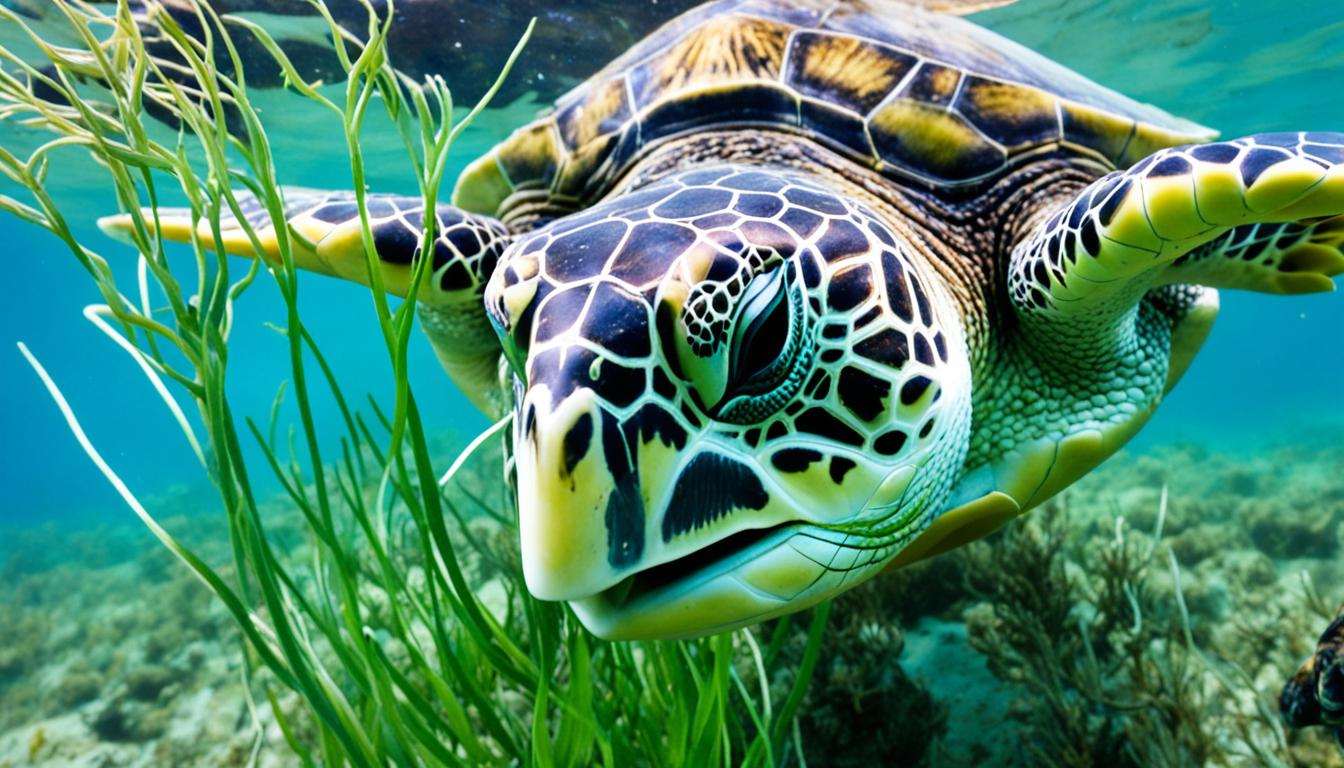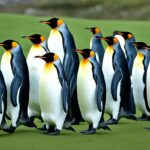Sea turtles play a big role in the ocean, and knowing what they eat helps us understand their importance. So, what do these amazing creatures eat? They come in seven different types, each with its own eating habits based on where they live and their age. Some eat mostly plants like seagrass and algae, while others prefer to eat animals like crabs and fish.
The way sea turtles eat is not just interesting; it’s also crucial for keeping the ocean healthy. As they grow, their eating habits change, which is important to know for their health and for protecting them. Let’s explore more about how sea turtles eat and why it matters.
Understanding Sea Turtle Diets
Sea turtles live in every ocean, except the Arctic. They have a wide variety of diet based on their species and where they live. Knowing about the sea turtle diet is key for protecting them. Each type of sea turtle has its own way of finding food, fitting their unique lives in different places like coral reefs and the open sea.
Green sea turtles start eating small animals as babies. But as they grow up, they switch to eating mostly plants like seagrass and algae. This change shows how their eating habits change as they grow and where they live.
Learning about what sea turtles eat tells us a lot about their role in the ocean. Their diet changes based on where they live, their home, and the type of sea turtle. Knowing this helps us understand how to protect these amazing creatures.
What Do Sea Turtles Eat?
Sea turtles eat a wide variety of foods based on their species and where they live. Each type of sea turtle has its own diet that fits its needs. This helps them survive in different environments.
Overview of Sea Turtle Species and Their Diets
There are six main types of sea turtles: green, loggerhead, hawksbill, leatherback, olive ridley, and flatback. Each one eats differently. For example, green turtles mainly eat algae and seagrass. Loggerheads like to eat crabs and shrimp.
The Role of Species in Dietary Preferences
Sea turtles’ diets are shaped by their species. Hawksbills have special jaws for eating sponges from coral reefs. Leatherbacks mainly eat jellyfish. Knowing what sea turtles eat helps us protect them.
| Sea Turtle Species | Main Diet |
|---|---|
| Green Turtle | Algae and Seagrass |
| Loggerhead Turtle | Crustaceans (Crabs, Shrimp) |
| Hawksbill Turtle | Sponges |
| Leatherback Turtle | Jellyfish |
| Olive Ridley Turtle | Various Invertebrates |
| Flatback Turtle | Soft Corals and Invertebrates |
Different Feeding Habits of Sea Turtles
Sea turtles have different ways of eating, mainly as herbivores and carnivores. Their diets show how they fit into their environments.
Herbivorous vs. Carnivorous Species
Herbivorous sea turtles, like the green turtle, eat mostly underwater plants. They eat seagrasses and algae. This helps keep coral reefs healthy by controlling algae growth. On the other hand, carnivores like loggerheads and leatherbacks eat animals and jellyfish. Their eating habits help keep the ocean balanced by controlling animal populations.
Impact of Life Stages on Diet
Sea turtles change what they eat as they grow. Baby turtles start with small animals and tiny plants. As they get older, they eat more plants, like seagrass and algae. Loggerheads also change their diet, eating more meat as they grow up. This shows how important growth is for what sea turtles eat.
| Species | Diet Type | Primary Food Sources |
|---|---|---|
| Green Turtle | Herbivorous | Seagrasses, Algae |
| Loggerhead Turtle | Carnivorous | Invertebrates |
| Leatherback Turtle | Carnivorous | Jellyfish |
| Hawksbill Turtle | Carnivorous | Sponges |
Types of Food Sea Turtles Consume
Sea turtles play a big role in the ocean’s balance. They eat different foods based on where they live and their needs. Each type of sea turtle has its own favorite foods.
Algae and Seagrass: The Greens’ Favorites
Green sea turtles love to eat algae and seagrasses. These plants are key for their health and growth. They live in areas with lots of seagrass, which is great for them and the ocean.
This helps keep the ocean healthy by stopping plants from taking over. It’s a win-win for everyone living in the sea.
Crustaceans and Invertebrates: The Loggerhead and Kemp’s Ridley Diets
Loggerhead and Kemp’s ridley sea turtles eat crustaceans and other small animals. Loggerheads have strong jaws to break open hard shells. Kemp’s ridleys prefer softer animals, showing how different they are.
This variety in what they eat shows how sea turtles adapt to their surroundings.
Jellyfish: The Leatherback’s Primary Food Source
Leatherback turtles mainly eat jellyfish in the open ocean. Their jaws are made just right for eating jellyfish. This helps keep jellyfish numbers in check, which affects the whole ocean.
Sponges: The Hawksbill’s Specialized Diet
Hawksbill turtles mostly eat sponges. They use their beaks to get into tight spots in coral reefs. Eating sponges helps keep coral reefs healthy and controls sponge numbers.

Oceanic Turtle Feeding Habits
Oceanic turtles have unique ways of finding food that helps us understand their life in the ocean. They travel long distances to find the best places to eat. This is key for their survival and helping them reproduce.
Migratory Patterns and Feeding Grounds
Sea turtles, like the leatherback, have amazing migration patterns. They travel thousands of miles from Asia to the US West Coast to eat jellyfish. This shows how important certain places are for their food and affects the ocean’s balance.
Feeding in Coral Reef Ecosystems
Coral reefs are special for sea turtles when it comes to finding food. They eat algae and sponges there. This helps them stay healthy and keeps the reef healthy too. The link between turtles and coral reefs shows how their eating habits help the ocean stay diverse.
The Importance of Marine Turtle Nutrition
Knowing what marine turtles eat is key to understanding their health and survival. A balanced diet helps them grow, reproduce, and fight off diseases. If their diet lacks nutrients, they can get sick and their numbers can drop. It’s important to know their diet to help them recover and protect them.
How Diet Affects Sea Turtle Health
Sea turtles’ diets directly affect their health. They need different foods to stay healthy and fight infections. Herbivores eat seagrasses and algae, while carnivores eat invertebrates and jellyfish. Not getting enough nutrients can make them weak and more likely to get sick.
Contribution to Marine Ecosystems
Sea turtles also play a big role in marine ecosystems. They eat seagrass, which stops it from taking over and harming marine life. They help coral reefs by eating sponges and jellyfish. This shows why we need to protect them to keep our oceans healthy.










